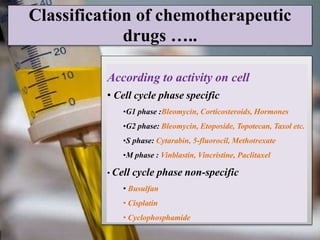Chemotherapy versus chemoradiotherapy after surgery and preoperative Biology Diagrams TABLE 1: Cell-cycle-phase-specific drugs S phase-dependent M phase-dependent Antimetabolites Vinca alkaloids a Capecitabine Vinblastine Cytarabine Vincristine chemotherapy drugs. It can be safely and conveniently adminis-tered with full doses of paclitaxel, doxorubicin, and vinorelbine with no compromise of pharmacokinet- Principles of Clinical Cancer Chemotherapy and Drug Resistance. Cancer Mortality: 2000 = 553,091; Est.2003 = 556,500 Cancer Chemotherapy -- Effectiveness by Disease. Cell Cycle Active, S Phase Specific. ANTIMETABOLITES. Mechanisms. incorporation of nucleotide analog in DNA or RNA, resulting in abnormal nucleic acids

Cell cycle-specific chemotherapy drugs are a type of chemotherapy drugs that kill cancer cells during their proliferation. There are two types of cell cycle-specific chemotherapy drugs. They are antimetabolites and plant alkaloids. Antimetabolites. Antimetabolites replace the natural substances used by the cancer cells to divide. Antibiotics, PARP inhibitors, and antimetabolites work in the S phase. When formulating combination chemotherapy regimens, oncologists often look for two drugs that work in different parts of the cycle. Other chemotherapeutic agents kill multiplying cells in all phases. They are not phase-specific and are sometimes called CCNS, cell-cycle non The cell cycle has four stages: mitosis, gap-1, synthesis phase (S-phase) and gap-2. DNA synthesis occurs in S-phase, chromosomes then align, separate, and cell division takes place during mitosis. Chemotherapy drugs cause cell death by apoptosis, either by directly interfering with DNA, or by targeting the key proteins required for cell division.

The Cell Reproductive Cycle and Cytotoxic Drugs Biology Diagrams
Repeat doses of chemotherapy may be given to keep killing cancer cells. Cell-Cycle Specific Chemotherapy. These attack cancer cells during specific phases of the cell cycle, but never during the resting phase. These are often given more than once. This gives the chemotherapy the best chance to kill as many cells as possible. cell cycle for a cycle specific drug (e.g., the S-phase fraction for an S-phase specific drug like fluorouracil), and a scaling factor for the level of drug resistance. Although this model is not as detailed or accurate as those described above by Jusko and Ozawa et al. 29-31 it is more convenient because the parameters are easier to estimate from A special note to the reader: all the chemotherapy drugs discussed herein can be found on OncoLink Rx.. History of chemotherapy. Chemotherapy, or the use of chemical agents to destroy cancer cells, is a mainstay in the treatment of malignancies.The possible role in treating illness was discovered when the bone marrow suppressive effect of nitrogen mustard was noted in the early 1900's.
